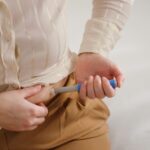Medical Review by Jennie Stanford, MD, FAAFP, DipABOM
Summary:
- Finasteride and minoxidil foam are scientifically proven treatments for hair loss, especially in male pattern baldness.
- A balanced diet rich in proteins, iron, vitamins, and minerals supports hair growth and health.
- Regular scalp cleansing, avoiding excessive heat styling, and minimizing hair stress can also help prevent hair damage and loss.
- Managing stress, exercising regularly, ensuring adequate sleep, staying hydrated, and limiting alcohol and tobacco intake contribute to healthier hair.
Halting your receding hairline might not be as hard as you think
There are lots of reasons why your hair might start to thin or fall out. Some of the most common ones include male-pattern baldness from hormone imbalances, as well as genetic predispositions, autoimmune disorders, scalp infections, and stress.
Starting to lose your hair can come with a lot of feelings—but the good news is, you don’t have to just let it happen. There are actually a lot of different ways to address this issue. Here are 8 proven ways to stop or slow down hair loss.
Learn about more online hair loss treatments
Taking FDA-approved hair loss medications like finasteride & minoxidil
Finasteride and minoxidil are two of the most well-known and scientifically backed treatments for hair loss, particularly male pattern baldness. Understanding how they work and what makes them effective can help you make informed decisions.
- Minoxidil, originally used to treat high blood pressure, was found to have the side effect of hair growth. Applied topically, minoxidil foam can help stimulate hair growth and slow hair loss.
- Finasteride is an oral medication that works by inhibiting the hormone dihydrotestosterone (DHT), which is implicated in the development of male pattern baldness. Clinical trials have shown that finasteride effectively slows hair loss and promotes hair regrowth in men.
Some studies also suggest that using both finasteride and minoxidil together may be more effective than using either one alone.
Maintaining a balanced diet
A healthy diet is not just important for your body’s overall well-being. What you eat can also play a role in how healthy your hair is.
- A protein-rich diet supports hair growth because hair follicles are mostly made of protein.
- Iron deficiency can contribute to hair loss—particularly in women, but potentially in men as well. Try raising your iron levels by taking oral supplements or eating iron-rich foods.
Practicing scalp care & hygiene
Because certain scalp conditions can contribute to hair loss, it’s important to keep your scalp clean and healthy. This creates a better environment to support and promote hair growth by lowering the risks of several conditions.
- Keeping your scalp clean with gentle, regular washing helps prevent build-up of oils, sweat, and skin cells, which can lead to dandruff and hair loss.
- Scalp massaging is not just relaxing—it may also boost hair thickness by stimulating blood circulation.
- Avoiding harsh chemicals and ingredients in hair products protects your scalp’s natural oil balance, which is vital for healthy hair growth.
Avoiding excessive heat & styling
Frequent styling and heat exposure can wreak havoc on your hair, leading to brittleness, breakage, and hair loss. You can reduce the damage this causes by finding gentler ways to style your hair.
- Try using heat styling tools like straighteners, curling irons, and blow dryers less often—or switch them to lower settings when possible. Repeated thermal hair straightening changes hair’s keratin structure, leading to fragility.
- Hairstyles that pull on the hair, like tight ponytails or braids, can cause tension alopecia, a form of hair loss. Try choosing hairstyles that put less stress on your hair.
- Consider using protective styles and heat protectant sprays. These can reduce the damage caused by heat styling and cause less hair loss from thermal breakage.
Managing stress levels
Stress can impact your body in many ways, including your hair health. High-stress levels can lead to several types of hair loss, including telogen effluvium and alopecia areata.
Both of these conditions are linked to the stress hormone cortisol. Studies suggest that lowering your stress levels through relaxing activities like listening to music can reduce cortisol levels in hair and potentially help treat associated hair loss.
Enjoying regular exercise
Regular exercise is more than just great for staying in shape—it may also play a role in maintaining healthy hair. Doing at least 60 minutes of aerobic exercise several times per week can delay the progress and reduce the symptoms of hair loss.
This research suggests that exercise may help with hair loss by improving scalp health, reducing stress related to anxiety and depression, and improving sleep quality (read more below).
Getting adequate sleep
Lack of sleep is linked to stress, which is a known cause of hair loss. Additionally, sleep disturbances have been linked directly to hair loss from androgenetic alopecia.
Here are some ways that you can improve the quality of your sleep:
- Aim for 7-9 hours of good quality sleep each night.
- Establish a regular sleep schedule and bedtime routine
- Try regular exercise (see above) and mindfulness practices
- Avoid excessive caffeine, alcohol (see below), heavy metals, and exposure to bright light (especially later in the day).
Limiting alcohol & tobacco
The consumption of alcohol and the use of tobacco products have also been shown to have to a negative impact on hair health. Moderating these habits is important for maintaining healthy hair.
- Alcohol consumption may increase the risk of hair loss from alopecia areata by triggering an immune response. However, drinking in moderation may actually help reduce the psychological stress that is associated with this type of hair loss, so more research is needed.
- Smoking tobacco causes inflammation that might contribute to alopecia areata. It is important to avoid smoking if you are suffering from this type of hair loss.
Finding professional support for hair loss
Support from a qualified healthcare professional can also be an important part of finding a hair loss plan that works for you. At Lemonaid Health, our team of medical professionals is ready to help you create a safe and effective plan to help you prevent hair loss or manage its impact on your life.












